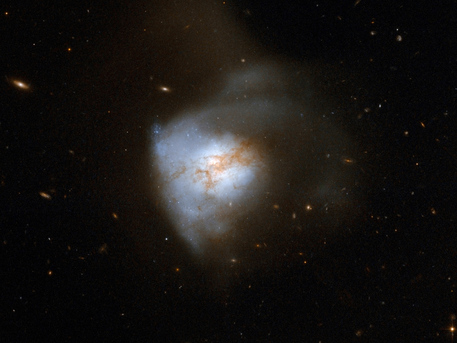Supercharged Star Factory
Sharpest View
 |
Arp 220 is a nearby example of a merged starburst galaxy similar to SMM J2135-0102. Located 250 million light-years from Earth, Arp 220 is the aftermath of a collision between two spiral galaxies. The collision, which began about 700 million years ago, has sparked a crackling burst of star formation. The star clusters are the bluish-white bright knots visible in the Hubble image. (c) NASA, ESA, the Hubble Heritage-ESA/Hubble Collaboration, and A. Evans (UVa/NRAO/Stony Brook)
The galaxy, while heavily obscured by dust at visible wavelengths, emits prodigious amounts of light at submillimeter wavelengths (close to the radio region of the spectrum). Indeed, it is the brightest known submillimeter galaxy, making it a natural target for the Submillimeter Array (SMA).
The SMA is an 8-element interferometer operating in the wavelength range of 0.3 to 2 millimeters, located atop Mauna Kea in Hawaii. Combined with the natural magnification of the gravitational lens, the array provided extremely high resolution observations - equivalent to using a telescope in Boston to spot a dime in Washington DC. This yielded a level of detail for a galaxy 10 billion light-years away comparable to the best observations of nearby starburst galaxies (which also show high rates of star formation).
Because of the obscuring dust, the galaxy's distance could not be determined by observations of visible light. For that task, the astronomers turned to a unique instrument, called the "Zpectrometer," on the National Science Foundation's Robert C. Byrd Green Bank Telescope. This instrument was able to determine the galaxy's distance by measuring radio emission from carbon monoxide molecules. The precise distance measurement allowed the scientists to determine "the exact effect that gravitational lensing would have on the galaxy, and therefore exactly how the galaxy would look in the absence of lensing," according to Andrew Baker, of Rutgers University.
Star Factories
The SMA data revealed four extremely bright star-forming regions. The large luminosities, 100 times greater than typical for nearby galaxies, imply a very high rate of star formation.
"We don't fully understand why the stars are forming so rapidly, but our result suggests that stars formed much more efficiently in the early universe than they do today," said Swinbank.
Their results provide new insight into a critical time during the Universe's history. SMM J2135-0102 is seen at the epoch when the majority of all stars were born, and therefore when many of the properties of nearby galaxies were defined. By studying it and other distant galaxies in the young Universe, astronomers hope to learn about the history of the Milky Way and other nearby galaxies.
Future surveys should identify more targets for study by the SMA and next-generation telescopes such as the Atacama Large Millimeter Array.
"That will allow us to test exactly how generic our results are: Is the star formation occurring within galaxies in the early Universe always so vigorous? Or are we catching this particular galaxy at a very special time?" said Longmore.
Supercharged Star Factory
Sharpest View
 |
Arp 220 is a nearby example of a merged starburst galaxy similar to SMM J2135-0102. Located 250 million light-years from Earth, Arp 220 is the aftermath of a collision between two spiral galaxies. The collision, which began about 700 million years ago, has sparked a crackling burst of star formation. The star clusters are the bluish-white bright knots visible in the Hubble image. (c) NASA, ESA, the Hubble Heritage-ESA/Hubble Collaboration, and A. Evans (UVa/NRAO/Stony Brook)
The galaxy, while heavily obscured by dust at visible wavelengths, emits prodigious amounts of light at submillimeter wavelengths (close to the radio region of the spectrum). Indeed, it is the brightest known submillimeter galaxy, making it a natural target for the Submillimeter Array (SMA).
The SMA is an 8-element interferometer operating in the wavelength range of 0.3 to 2 millimeters, located atop Mauna Kea in Hawaii. Combined with the natural magnification of the gravitational lens, the array provided extremely high resolution observations - equivalent to using a telescope in Boston to spot a dime in Washington DC. This yielded a level of detail for a galaxy 10 billion light-years away comparable to the best observations of nearby starburst galaxies (which also show high rates of star formation).
Because of the obscuring dust, the galaxy's distance could not be determined by observations of visible light. For that task, the astronomers turned to a unique instrument, called the "Zpectrometer," on the National Science Foundation's Robert C. Byrd Green Bank Telescope. This instrument was able to determine the galaxy's distance by measuring radio emission from carbon monoxide molecules. The precise distance measurement allowed the scientists to determine "the exact effect that gravitational lensing would have on the galaxy, and therefore exactly how the galaxy would look in the absence of lensing," according to Andrew Baker, of Rutgers University.
Star Factories
The SMA data revealed four extremely bright star-forming regions. The large luminosities, 100 times greater than typical for nearby galaxies, imply a very high rate of star formation.
"We don't fully understand why the stars are forming so rapidly, but our result suggests that stars formed much more efficiently in the early universe than they do today," said Swinbank.
Their results provide new insight into a critical time during the Universe's history. SMM J2135-0102 is seen at the epoch when the majority of all stars were born, and therefore when many of the properties of nearby galaxies were defined. By studying it and other distant galaxies in the young Universe, astronomers hope to learn about the history of the Milky Way and other nearby galaxies.
Future surveys should identify more targets for study by the SMA and next-generation telescopes such as the Atacama Large Millimeter Array.
"That will allow us to test exactly how generic our results are: Is the star formation occurring within galaxies in the early Universe always so vigorous? Or are we catching this particular galaxy at a very special time?" said Longmore.





